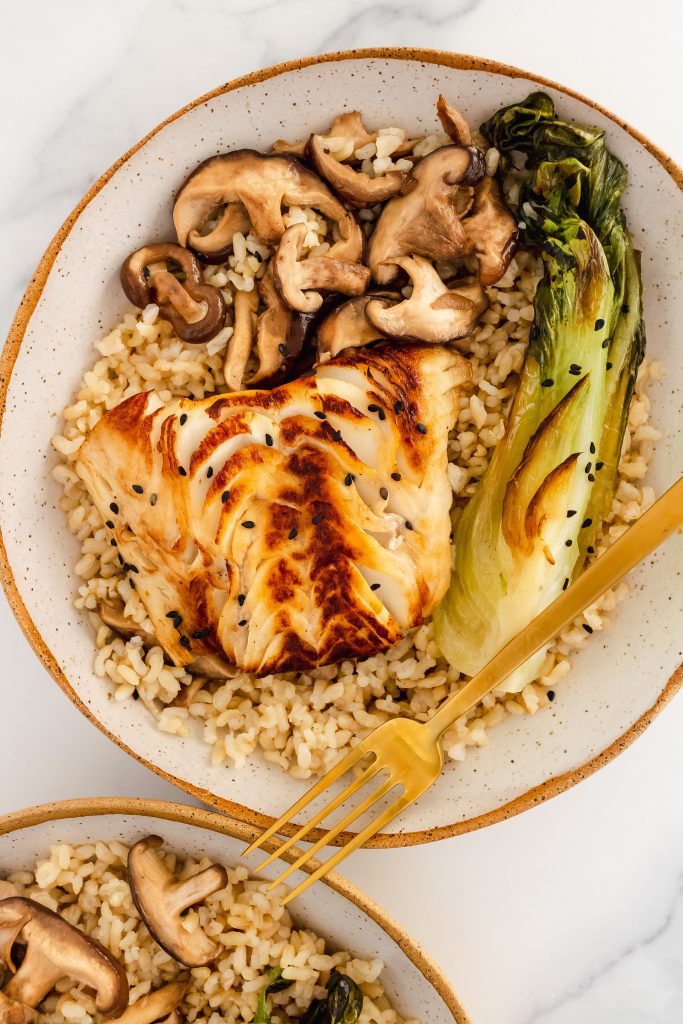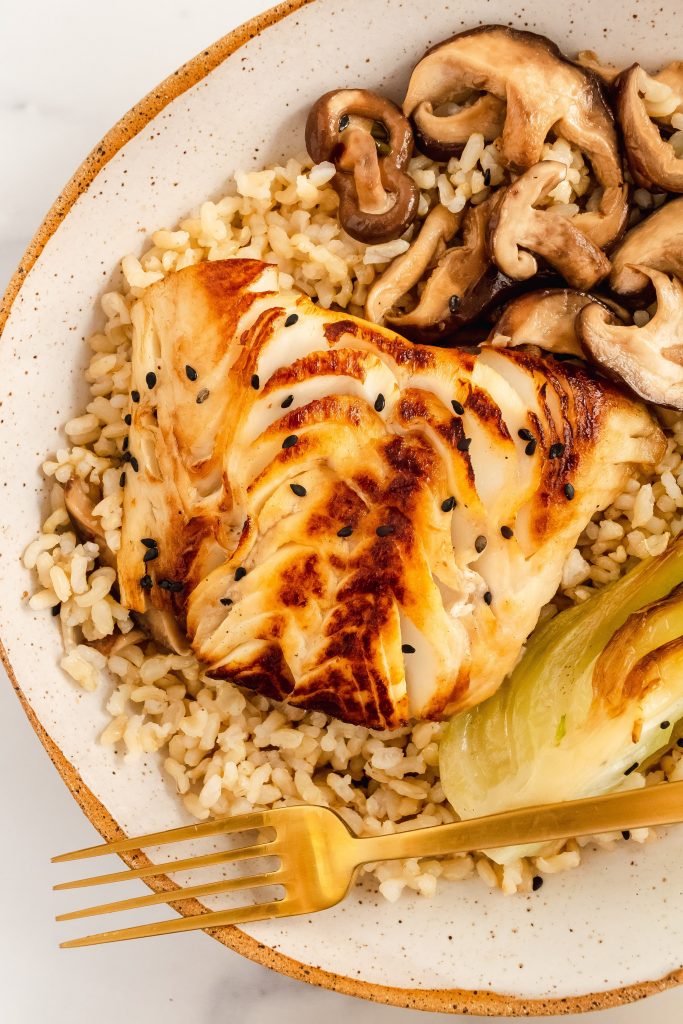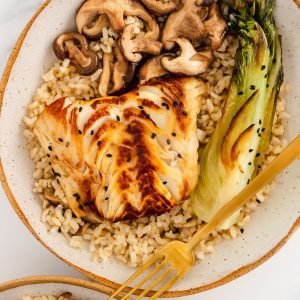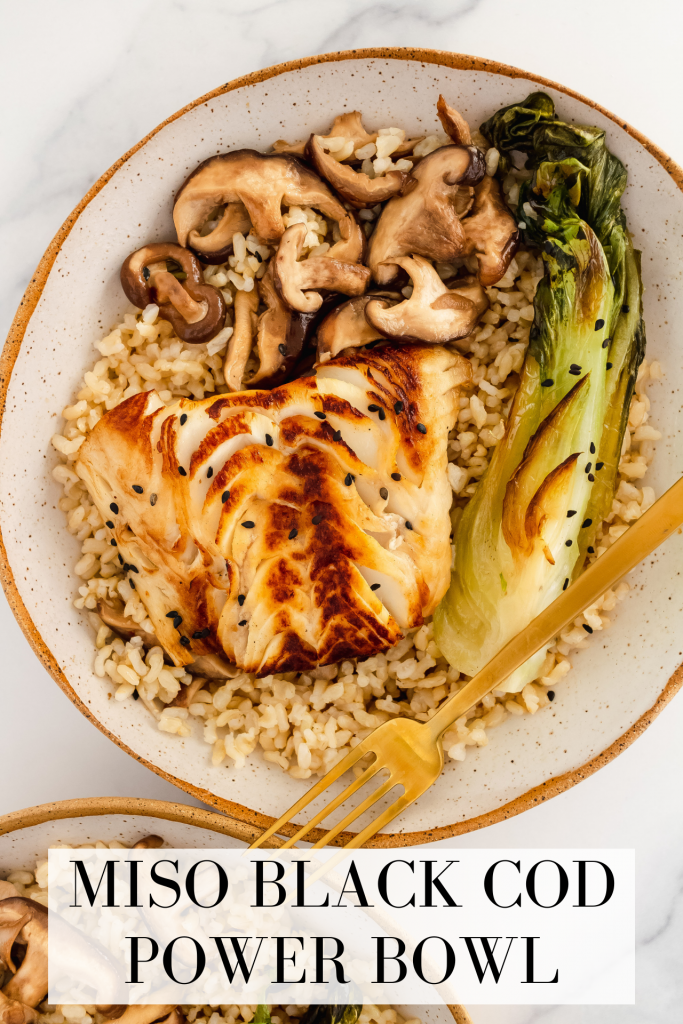Miso black cod power bowl made with flaky black cod, sprouted brown rice, baby bok choy and shiitake mushrooms makes for a delicious and nutritious meal that’s easy to make and channels Asian flavors in every bite.

Inspired by the miso black cod dish at Nobu, I decided to make my own miso black cod power bowl for a well-rounded, easy to make meal at home that has all of the same delicious Asian flavors. And let me tell you, you’re going to want to cancel your reservation at Nobu after you try my easy to make homemade version!
This recipe highlights black cod (aka sablefish) from Alaska that has a rich, buttery flavor and really takes on the flavors of any seasonings and spices you cook it with. Until recently if you asked me, I would say salmon is my favorite fish to eat, however since trying black cod it now takes the top spot!
Whether salmon or cod, or shrimp or sea bass, fish is a freezer staple of mine — I always have some on hand to build quick and nutritious meals during the week. I love that it’s quick to thaw and can be made with so many different flavor combinations! Follow along on Instagram for more fun recipes like this one.
Seafood Nutrition
I’m a huge advocate of including more seafood into the diet and I strive to eat it at least 2 times per week.
Not only is seafood so versatile, but it’s also a nutrient-packed food that reduces inflammation with vitamins A, B, and D, as well as omega-3 fatty acids and minerals such as calcium, selenium, phosphorus, iron, zinc, iodine, magnesium and potassium.
Omega-3 fatty acids, EPA + DHA, play important roles in supporting the immune system. We need to get this type of healthy fat from our diets because our body doesn’t make them and seafood is a great source.
The omega-3s found in seafood help reduce inflammation in the body and support healing. Different species of seafood offer different amounts of omega-3 fatty acids. Salmon, herring, anchovies, oysters, sardines and trout have the highest amount of omega-3s.
Is fresh or frozen seafood better?
This is similar to fresh or fruit fruit or vegetables. Frozen does not equal less nutritious!
Fish that are caught at sea are often frozen on vessels within minutes of being caught or processed dockside—that means frozen seafood is usually as fresh as it was when it came out of the water.
Seafood Sustainability
I’m sure you’ve heard the word “sustainable” a lot lately when it comes to food, household items, clothing and more.
With Earth month in April, it’s a great time to stop and evaluate the choices we’re making and how they are impacting the planet. Something as small as switching from plastic bags to reusable silicone storage bags is a small thing that can make a big difference for our planet in the long run.
By no means am I a sustainability expert. I can definitely be doing more which is why I feel good knowing making small choices like purchasing sustainable seafood is another way to be mindful of the impact my meals are making on the planet.
So what does sustainable seafood really mean?
Sustainable seafood means that wild caught seafood comes from a well-managed fishery and farmed seafood comes from a farm following responsible practices.
The good news is that the United States is a global leader when it comes to managed fisheries and seafood sustainability. I love Alaska seafood, like the black cod in this recipe.
What does seafood certifications mean?
Certification provides a level of assurance that the product is sustainable/responsible, is harvested legally, and is traceable back to its source. Certifications directly engage with fisheries or farms and require them to address social and environmental challenges to improve and meet the certification standard. Certifications also engage with the supply chain to verify the sustainability/responsibility and origin of certified products.
Common certifications to look for include:
Aquaculture Stewardship Council (ASC) and Best Aquaculture Practices (BAP) for farmed fish; Marine Stewardship Council (MSC) and Alaska Responsible Fisheries Management (RFM) for wild-caught fish; Fair Trade and any seafood certification programs benchmarked against GSSI.
Sustainability & Overfishing
Fish and shellfish are renewable resources—they can reproduce and replenish their populations naturally. Because of this, we can sustainably harvest fish within certain limits without depleting the resource, given proper management. Fishery managers, such as the National Oceanic and Atmospheric Administration (NOAA Fisheries) here in the United States, use science to determine these limits, ensuring that the right amount of fish are caught while enough are left in the ocean to reproduce and replace the fish that were harvested.
One of the requirements for all fisheries in the MSC program is to ensure that fish populations are healthy and thriving and can reproduce indefinitely.
Tips for choosing sustainable seafood:
- Most grocery stores have high standards in place to ensure their seafood has been sustainably caught. About 90% of U.S. retailers have seafood sustainability purchasing programs in place. More info about them is typically posted on their website.
- Look for certification logos: ASC, BAP, MSC.
- Buy U.S. seafood. The United States is a global leader in responsibly managed fisheries and sustainable seafood.

Ingredients for miso black cod power bowl:
- Sablefish (black cod)
- Sprouted brown rice
- Baby bok choy
- Shiitake mushrooms
- Coconut aminos or low sodium soy sauce
- Fresh ginger
- Fresh garlic
- Fresh lime juice
- White miso
- Sesame oil
- Salt and pepper
- Sesame seeds
Tips for preparing fish:
- Thaw frozen fish under refrigeration and once thawed do not refreeze fish.
- Use a fish spatula to gently flip the fish over when searing on a pan.

Miso Black Cod Power Bowl
Ingredients
- 1 cup sprouted brown rice
- 2 6oz. black cod (sablefish) fillets
- 2 tbsp. coconut aminos or low sodium soy sauce
- 2 tbsp. white miso paste
- 1 tbsp. rice wine vinegar
- 2 tsp. sesame oil divided
- 2 tsp. honey
- 1 tbsp. minced garlic
- 2 tsp. minced ginger
- 1/4 tsp. red chili flakes
- 2 tbsp. avocado oil divided
- 1-2 baby bok choy
- 1 cup shiitake mushrooms
- ¼ tsp. black or white sesame seeds
Instructions
- In a small bowl combine the coconut aminos or soy sauce, miso paste, rice wine vinegar, sesame oil, honey, garlic, ginger, and red pepper flakes. Whisk together, and pour about 3/4 of the mixture over the fish. Place in a covered container and refrigerate for 30 minutes.
- While the fish marinates, cook the brown rice according to the package directions.
- Remove the fish from the fridge, preheat the oven to 400 degrees F. Heat avocado oil in a sauté pan over medium heat. Take the fish out of the marinade liquid, and place it skin side up to sear on the heated pan for about 1-2 minutes before flipping to the other side. You should see a nice golden sear before flipping to the over side. Once seared, place fish on a parchment lined baking sheet in the oven for about 10-12 minutes until fully cooked and flakey.
- While the black cod is in the oven, sauté the bok choy and shiitake mushrooms. Pour what’s left of the marinade over the bok choy and cleaned mushrooms and sauté it in the same pan used for the cod. Add the bok choy first, searing it so that it gets a little golden brown. Remove and cook the mushrooms with a little extra oil if necessary until tender.
- Assemble the power bowls by adding the dividing the rice, bok choy, mushrooms, and black cod fillets among 2 bowls. Sprinkle extra sesame seeds on top if desired and enjoy!
This recipe was created in partnership with the Seafood Nutrition Partnership. As always all opinions are my own and I appreciate your support!
More seafood recipes you’re sure to love:
- Pumpkin risotto with scallops
- Easy lemon dill salmon cakes
- Turmeric oat salmon cakes
- Autumn salmon and squash bowl
- Honey citrus glazed salmon
- Blackened cod fish tacos
Pin this recipe for later!


